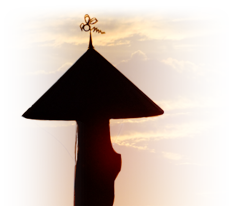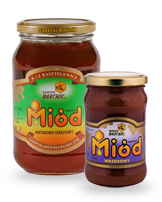|
Beehive of the Millennium Beekeeping Museum |
Did you know?
Flower pollen – natural multivitamin
In botany plants that produce pollen are divided into two group : anemophilous and entomophilous.
The main source of pollen for bees are entomophilous plants. For instance, apple tree flower produces from 70 thousand to 100 thousand of pollen grains. The pollen efficiency of a buckwheat oscillates between 178 and 394 kg for a hectare of plantation.
The majority of pollen plants blossoms in May and June.
Bees, just like other insects, are extremely sensitive to smell. The pollen is produced by a plant in the anther that is the male reproductive organs of the flower. Pollen grains of entomophilous plants do not float in the air as it is the case with anemophilous plant, but remain in the flower until they are collected by insects. The size of the grain varies, as well as, its shape and colour. A bee uses its mandible to get through anther and lick off the the pollen with its tongue. Next, the pollen, with the use of nectar and saliva, is formed into small balls and located in the basket of bee's third pair of legs. Mixing pollen with nectar or honey makes it more valuable.
To form one load of pollen bee must find from 7 to 20 flowers. In order to collect 1 kg of pollen it has to make 66 thousand flights. Assuming that bee collects one load of pollen about 20 min. and is capable of making 20 flights in a day, there has to be 3300 of bees to collect the mention above quantity. Bees fly round plants in 500 m radius in 100%, in 1000 m radius in in 30-40% and in 1500 m radius in 10%. It is also tremendously important for agriculture.
The largest amount of pollen is collected in sunny weather after rainy days. The impulse that makes bees to intensify their flights is the brood of the a queen. The more eggs it lays, the bigger demand for pollen there is. Larvas secrete special pheromones that provoke bees to fly more frequently.
Worker bees bring the pollen load to the right place and throw it down to a cell in a comb. The pollen processing is made by hive bees that mix it precisely, adding 25% of honey and saliva. After that, they ram it with their heads and coat it with honey. Such pollen mass undergoes the process of fermentation. The ready-made product is covered with a thin layer of propolis to prevent moisture from absorbing. If the pollen is intended for winter reserve it is poured over with honey and sealed up. Pollen reserves deposited in cells are called beebread.
.
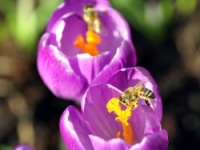
It is difficult to find in nature equally rich in nutrients product as flower pollen. There are over 250 different nutritens contained in it, among others carbohydrates (25-48%), fat (2-4%), proteins (on average 25%) with amino acids (12%), mineral elements including potassium, calcium, magnesium, gold, zink, copper, iodine and others. In addition, pollen is accumulation of vitamins: B1, B2, B6, A, E, C, D and folic acid. And it's not all! .
It is confirmed pollen is rich in rutin, ethereal oils, fitoncids, antibiotics, hormones and enzymes.
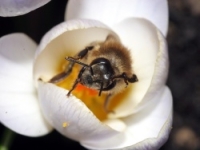 It is still unknown how pollen is digested in human system. However, it is proved that effectiveness of flower pollen is not as substantial as it is in case of beebread. Unfortunately, beebread comes in limited quantity, while pollen reserves are incomparably more abundant.
It is still unknown how pollen is digested in human system. However, it is proved that effectiveness of flower pollen is not as substantial as it is in case of beebread. Unfortunately, beebread comes in limited quantity, while pollen reserves are incomparably more abundant.
According to the most cautious calculations, assuming that that a beekeeper acquires from one beehive only 0,5 kg of pollen, it is more than feasible to acquire 100 tons per year.
Flower pollen has is recommended in every possible form and shape. For example, French pollen lovers consume it in its natural from mixed with butter or jam, dosed 20 g every day or 32 g of loading dose in two to three dosage before meals. For children doses are smaller: 3-5 years old 12 g a day, 12-16 years old 16 g a day.
The variety of nutrients contained in pollen constitutes its strength. When can it be used? Pollen if perfect for lack of appetite underweight and digestive system disorders. It is also beneficial for physical exhaustion and discomfort as it gives more strength to live. That is also why, it is sometimes referred as 'narcotic'. Pollen can also improve sight, strengthen hair and prevent them from falling. It is also used in cosmetics production. What is more interesting, it is appreciated by sportsmen and astronauts who better tolerate the state of zero gravity.
Nowadays, pollen is highly values as a supplement and prediction for its future use are much more extensive. It is possible pollen will become the basic product regulating the work of a human body from birth till advanced age.
Text: Dr Jacek Roik
Photo: Tomasz Kasztelewicz© Sądecki Bartnik 2008. All rights reserved.
The main source of pollen for bees are entomophilous plants. For instance, apple tree flower produces from 70 thousand to 100 thousand of pollen grains. The pollen efficiency of a buckwheat oscillates between 178 and 394 kg for a hectare of plantation.
The majority of pollen plants blossoms in May and June.
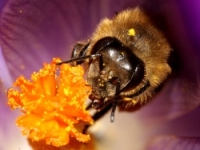 |  |
Bees, just like other insects, are extremely sensitive to smell. The pollen is produced by a plant in the anther that is the male reproductive organs of the flower. Pollen grains of entomophilous plants do not float in the air as it is the case with anemophilous plant, but remain in the flower until they are collected by insects. The size of the grain varies, as well as, its shape and colour. A bee uses its mandible to get through anther and lick off the the pollen with its tongue. Next, the pollen, with the use of nectar and saliva, is formed into small balls and located in the basket of bee's third pair of legs. Mixing pollen with nectar or honey makes it more valuable.
To form one load of pollen bee must find from 7 to 20 flowers. In order to collect 1 kg of pollen it has to make 66 thousand flights. Assuming that bee collects one load of pollen about 20 min. and is capable of making 20 flights in a day, there has to be 3300 of bees to collect the mention above quantity. Bees fly round plants in 500 m radius in 100%, in 1000 m radius in in 30-40% and in 1500 m radius in 10%. It is also tremendously important for agriculture.
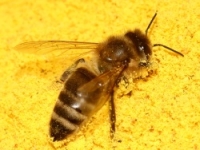 | 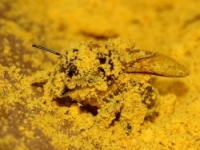 |
The largest amount of pollen is collected in sunny weather after rainy days. The impulse that makes bees to intensify their flights is the brood of the a queen. The more eggs it lays, the bigger demand for pollen there is. Larvas secrete special pheromones that provoke bees to fly more frequently.
Worker bees bring the pollen load to the right place and throw it down to a cell in a comb. The pollen processing is made by hive bees that mix it precisely, adding 25% of honey and saliva. After that, they ram it with their heads and coat it with honey. Such pollen mass undergoes the process of fermentation. The ready-made product is covered with a thin layer of propolis to prevent moisture from absorbing. If the pollen is intended for winter reserve it is poured over with honey and sealed up. Pollen reserves deposited in cells are called beebread.
.

It is difficult to find in nature equally rich in nutrients product as flower pollen. There are over 250 different nutritens contained in it, among others carbohydrates (25-48%), fat (2-4%), proteins (on average 25%) with amino acids (12%), mineral elements including potassium, calcium, magnesium, gold, zink, copper, iodine and others. In addition, pollen is accumulation of vitamins: B1, B2, B6, A, E, C, D and folic acid. And it's not all! .
It is confirmed pollen is rich in rutin, ethereal oils, fitoncids, antibiotics, hormones and enzymes.
 It is still unknown how pollen is digested in human system. However, it is proved that effectiveness of flower pollen is not as substantial as it is in case of beebread. Unfortunately, beebread comes in limited quantity, while pollen reserves are incomparably more abundant.
It is still unknown how pollen is digested in human system. However, it is proved that effectiveness of flower pollen is not as substantial as it is in case of beebread. Unfortunately, beebread comes in limited quantity, while pollen reserves are incomparably more abundant.According to the most cautious calculations, assuming that that a beekeeper acquires from one beehive only 0,5 kg of pollen, it is more than feasible to acquire 100 tons per year.
Flower pollen has is recommended in every possible form and shape. For example, French pollen lovers consume it in its natural from mixed with butter or jam, dosed 20 g every day or 32 g of loading dose in two to three dosage before meals. For children doses are smaller: 3-5 years old 12 g a day, 12-16 years old 16 g a day.
The variety of nutrients contained in pollen constitutes its strength. When can it be used? Pollen if perfect for lack of appetite underweight and digestive system disorders. It is also beneficial for physical exhaustion and discomfort as it gives more strength to live. That is also why, it is sometimes referred as 'narcotic'. Pollen can also improve sight, strengthen hair and prevent them from falling. It is also used in cosmetics production. What is more interesting, it is appreciated by sportsmen and astronauts who better tolerate the state of zero gravity.
Nowadays, pollen is highly values as a supplement and prediction for its future use are much more extensive. It is possible pollen will become the basic product regulating the work of a human body from birth till advanced age.
Text: Dr Jacek Roik
Photo: Tomasz Kasztelewicz© Sądecki Bartnik 2008. All rights reserved.
Copyright © 1997-2024 Gospodarstwo Pasieczne "Sądecki Bartnik" sp. z o.o. (dawniej Gospodarstwo Pasieczne "Sądecki Bartnik" Janusz Kasztelewicz)



